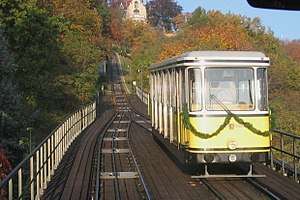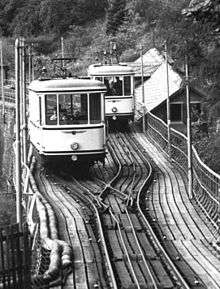Dresden Funicular Railway
The Dresden Funicular Railway (German: Standseilbahn Dresden) is a funicular in Dresden, Germany connecting the districts of Loschwitz, near the "Blue Wonder" bridge, and Weisser Hirsch.[1][2]
| Dresden Funicular Railway | |
|---|---|
 | |
| Overview | |
| Type | Funicular |
| Technical | |
| Track length | 547 metres (1,795 ft) |
| Track gauge | 1,000 mm (3 ft 3 3⁄8 in) metre gauge |
| Maximum incline | 29% |
| Rack system | Abt |
The railway is one of two funicular railways in Dresden, the other being the unusual Schwebebahn Dresden, a suspended monorail. Both lines are operated by the Dresdner Verkehrsbetriebe AG, who also operate the city's tram, bus and ferry networks.[2]
History
Although the construction of the line has been discussed and planned since 1873, the permit to build the railway was not issued until 1893. The railway was opened on October 26, 1895, and was originally run by a steam engine.[1][2][3]
In 1910 the line was converted to run on electricity, and in 1912 its operation was transferred to the Dresden municipal tramways, whose successors still operate it. During the bombing of Dresden on the 13 February 1945, the lower station of the funicular was destroyed. However the lines cars had been moved for safety into the line's tunnels and survived.[1][2][3]
Major renewals took place in 1978 and 1993. On January 6, 2014, the line was again closed for a major refurbishment of both the cars and the line. The refurbishment is expected to be completed by April, 2014 and to cost €350,000.[3][4]
Operation
The funicular operates between 06:30 and 21:00 on weekdays, and between 09:00 and 21:00 at weekends and public holidays. During operating hours there are between four and six journeys per hour in each direction.[5]
The line has the following technical parameters:[2][6]
| Number of cars | 2 |
| Number of stops | 2 |
| Configuration | Single track with passing loop |
| Traction | Electricity |
| Track length | 547 metres (1,795 ft) |
| Rise | 94 metres (308 ft) |
| Maximum gradient | 29% |
| Track gauge | 1,000 mm (3 ft 3 3⁄8 in) metre gauge |
| Speed | 5 metres per second (16 ft/s) |
| Journey time | 5 mins |
| Capacity | 60 passengers per car; 630 persons per hour per direction |
| Tunnels | Burgberg: 96 metres (315 ft) Prinzess Louisa: 54 metres (177 ft) |
| Viaduct | 102 metres (335 ft) |
Gallery
 Abt switch used in 1895 built Dresden Funicular Railway (photo of 1985)
Abt switch used in 1895 built Dresden Funicular Railway (photo of 1985) The line in 1910
The line in 1910 Entrance to lower station
Entrance to lower station The lower station
The lower station The upper station
The upper station
See also
References
- Gertoberens, Klaus (2006). Sächsische Erfindungen (in German). Dresden: Edition Sächsische Zeitung. ISBN 3-938325-31-3.
- "Die Standseilbahn" (in German). Dresdner Verkehrsbetriebe AG. Retrieved 2011-02-18.
- "Standseilbahn Dresden". bergbahngeschichte.de (in German). Retrieved 2014-01-14.
- "Verjüngungskur für Dresdner Standseilbahn bis Ostern" [Makeover for Dresden funicular to Easter] (in German). Dresdner Fernsehen. Retrieved 2014-01-14.
- "Haltestellenfahrpläne - Weißer Hirsch" (PDF). DVB. 2011-10-27. Retrieved 2012-11-13.
- "Weißer Hirsch". Funiculars.net. Retrieved 2009-03-23.
External links

- Standseilbahn page from Dresdner Verkehrsbetriebe web site (in German)